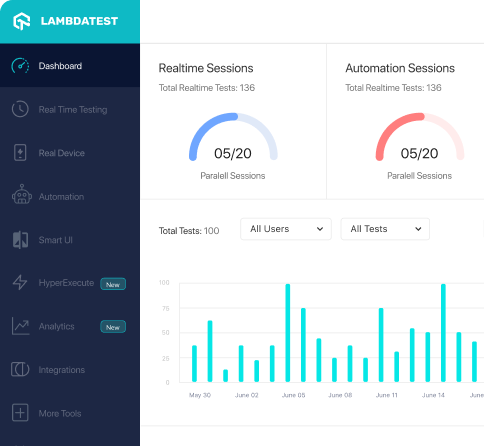How to use FlakyRuleTest class of org.testcontainers.testsupport package
Best Testcontainers-java code snippet using org.testcontainers.testsupport.FlakyRuleTest
Source:FlakyRuleTest.java
...4import org.junit.runners.model.Statement;5import java.lang.annotation.Annotation;6import static org.junit.Assert.assertEquals;7import static org.junit.Assert.fail;8public class FlakyRuleTest {9 private static final String VALID_URL = "http://some.url/here";10 private static final String INVALID_URL = "";11 private static final String VALID_DATE_IN_FAR_FUTURE = "2063-04-05";12 private static final String VALID_DATE_IN_PAST = "1991-08-16";13 private static final String INVALID_DATE = "91-01-45";14 private static final int DEFAULT_TRIES = 3;15 private FlakyTestJUnit4RetryRule rule = new FlakyTestJUnit4RetryRule();16 @Test17 public void testIgnoresMethodWithoutAnnotation() throws Throwable {18 final Description description = newDescriptionWithoutAnnotation();19 final DummyStatement statement = newStatement(3);20 try {21 rule.apply(statement, description).evaluate();22 fail("Should not reach here");...FlakyRuleTest
Using AI Code Generation
1public class FlakyRuleTest {2 public final FlakyTestRule flakyRule = new FlakyTestRule();3 public void testFlaky() {4 assertThat(1, is(2));5 }6}7@Flaky(maxRetries = 5)8public void testFlaky() {9 assertThat(1, is(2));10}11public class FlakyRuleTest {12 public final FlakyTestRule flakyRule = new FlakyTestRule();13 public void testFlaky() {14 assertThat(1, is(2));15 }16}17@Flaky(maxRetries = 5)18public class FlakyRuleTest {19 public final FlakyTestRule flakyRule = new FlakyTestRule();20 public void testFlaky() {21 assertThat(1, is(2));22 }23}24public class FlakyRuleTest {25 public final FlakyTestRule flakyRule = new FlakyTestRule();26 public void testFlaky() {27 assertThat(1, is(2));28 }29}30@Flaky(maxRetries = 5)31public class FlakyRuleTest {32 public final FlakyTestRule flakyRule = new FlakyTestRule();FlakyRuleTest
Using AI Code Generation
1 [junit4] Testcase: testSimple(org.testcontainers.junit.flaky.FlakyRuleTest): FAILED2 [junit4] at org.junit.Assert.fail(Assert.java:88)3 [junit4] at org.junit.Assert.failNotEquals(Assert.java:834)4 [junit4] at org.junit.Assert.assertEquals(Assert.java:645)5 [junit4] at org.junit.Assert.assertEquals(Assert.java:631)6 [junit4] at org.testcontainers.junit.flaky.FlakyRuleTest.testSimple(FlakyRuleTest.java:21)7 [junit4] at sun.reflect.NativeMethodAccessorImpl.invoke0(Native Method)8 [junit4] at sun.reflect.NativeMethodAccessorImpl.invoke(NativeMethodAccessorImpl.java:62)9 [junit4] at sun.reflect.DelegatingMethodAccessorImpl.invoke(DelegatingMethodAccessorImpl.java:43)10 [junit4] at java.lang.reflect.Method.invoke(Method.java:498)11 [junit4] at org.junit.runners.model.FrameworkMethod$1.runReflectiveCall(FrameworkMethod.java:50)12 [junit4] at org.junit.internal.runners.model.ReflectiveCallable.run(ReflectiveCallable.java:12)13 [junit4] at org.junit.runners.model.FrameworkMethod.invokeExplosively(FrameworkMethod.java:47)14 [junit4] at org.junit.internal.runners.statements.InvokeMethod.evaluate(InvokeMethod.java:17)15 [junit4] at org.junit.internal.runners.statements.FailOnTimeout$CallableStatement.call(FailOnTimeout.java:298)16 [junit4] at org.junit.internal.runners.statements.FailOnTimeout$CallableStatement.call(FailOnTimeout.java:292)17 [junit4] at java.util.concurrent.FutureTask.run(FutureTask.java:266)18 [junit4] at java.lang.Thread.run(Thread.java:748)19 [junit4] Testcase: testSimple(org.testcontainers.junit.flaky.FlakyRuleTest): FAILEDFlakyRuleTest
Using AI Code Generation
1open module org.testcontainers.testsupport {2 requires org.junit.jupiter.api;3 requires org.junit.jupiter.params;4 requires org.testcontainers;5 requires org.testcontainers.junit.jupiter;6 requires org.testcontainers.utility;7 requires org.slf4j;8 requires java.sql;9 requires java.desktop;10 requires java.management;11 requires java.naming;12 requires java.net.http;13 requires java.xml;14 requires java.annotation;15 requires java.logging;16 requires java.compiler;17 requires java.instrument;18 requires java.scripting;19 requires java.security.jgss;20 requires java.security.sasl;21 requires java.xml.crypto;22 requires org.hamcrest;23 requires org.hamcrest.core;24 requires org.junit.platform.commons;25 requires org.junit.platform.engine;26 requires org.junit.platform.launcher;27 requires org.junit.platform.runner;28 requires org.junit.platform.suite.api;29 requires org.junit.platform.testkit;30 requires org.junit.vintage.engine;31 requires org.opentest4j;32 requires org.slf4j.simple;33 exports org.testcontainers.testsupport;34}35package org.testcontainers.testsupport;36import org.junit.jupiter.api.extension.ExtendWith;37import org.junit.jupiter.api.extension.ExtensionContext;38import org.junit.jupiter.params.ParameterizedTest;39import org.junit.jupiter.params.provider.ValueSource;40import org.junit.jupiter.params.provider.Arguments;41import org.junit.jupiter.params.provider.MethodSource;42import org.junit.jupiter.params.provider.ArgumentsProvider;43import org.junit.jupiter.params.provider.ArgumentsSource;44import org.junit.jupiter.params.provider.ArgumentsProvider;45import org.junit.jupiter.params.provider.Arguments;46import org.junit.platform.commons.util.Preconditions;47import org.junit.platform.commons.util.ReflectionUtils;48import org.junit.platform.commons.util.StringUtils;49import org.junit.platform.commons.util.ToStringBuilder;50import org.junit.platform.commons.util.ExceptionUtils;51import org.junit.platform.commons.util.ClassUtils;52import org.junit.platform.commons.util.ReflectionUtils.HierarchyTraversalMode;53import org.junit.platform.commons.util.ReflectionUtils.FindMethodExAutomation Testing Tutorials
Learn to execute automation testing from scratch with LambdaTest Learning Hub. Right from setting up the prerequisites to run your first automation test, to following best practices and diving deeper into advanced test scenarios. LambdaTest Learning Hubs compile a list of step-by-step guides to help you be proficient with different test automation frameworks i.e. Selenium, Cypress, TestNG etc.
LambdaTest Learning Hubs:
- JUnit Tutorial
- TestNG Tutorial
- Webdriver Tutorial
- WebDriverIO Tutorial
- Protractor Tutorial
- Selenium 4 Tutorial
- Jenkins Tutorial
- NUnit Tutorial
- Jest Tutorial
- Playwright Tutorial
- Cypress Tutorial
- PyTest Tutorial
YouTube
You could also refer to video tutorials over LambdaTest YouTube channel to get step by step demonstration from industry experts.
Most used methods in FlakyRuleTest
- FlakyTestJUnit4RetryRule
- testIgnoresMethodWithoutAnnotation
- testRetriesMethodWithAnnotationUntilFailure
- testCustomRetryCount
- testRetriesMethodWithAnnotationUntilSuccess
- testDoesNotRetryMethodWithAnnotationIfNotThrowing
- testTreatsExpiredAnnotationAsNoAnnotation
- testThrowsOnInvalidDateFormat
- testThrowsOnInvalidGitHubUrl
- newDescriptionWithAnnotation
- newDescriptionWithoutAnnotation
- newDescriptionWithAnnotationAndCustomTries
- newDescriptionWithExpiredAnnotation
- newAnnotation
- annotationType
- githubIssueUrl
- reviewDate
- maxTries
- newStatement
- evaluate
Try LambdaTest Now !!
Get 100 minutes of automation test minutes FREE!!



